
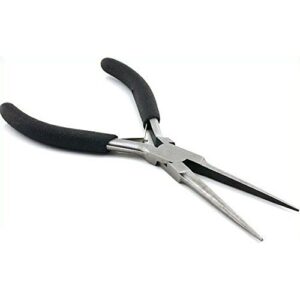
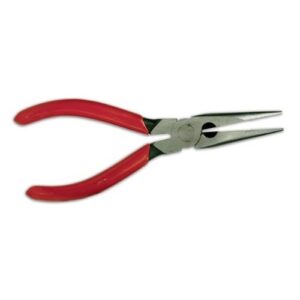
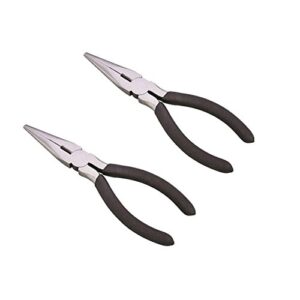
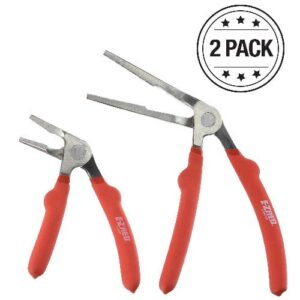
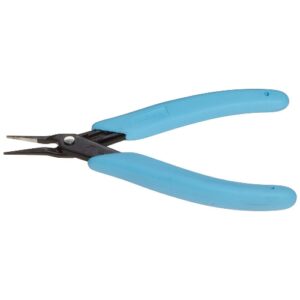
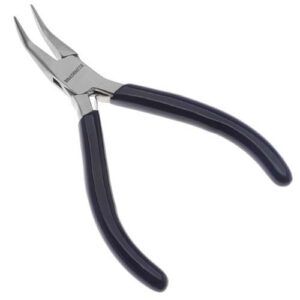
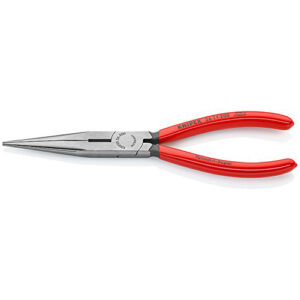
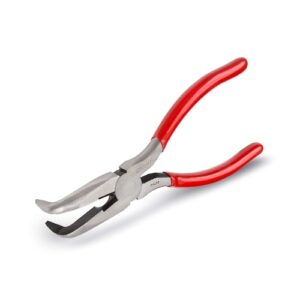
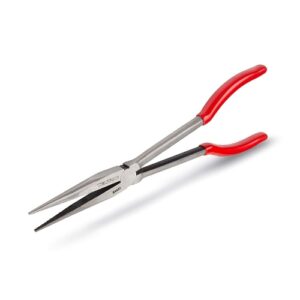
Customer’s Choice: the Best Rated Needle Nose Pliers
[survey_answers id=”1147275535″ style=”plain” data=”score”] users answered this survey. Please help us improve this review!
[survey_answers id=”1147275535″ style=”piechart” legend=”true”]
Needle nose pliers are a small but irreplaceable instrument that you may find in any toolbox. It is widely used by electricians who frequently pill, cut and bend wires. If you need to pick something really tiny and hold it for a while, needle-nose pliers can be also helpful.
The U.S. market is overloaded with different needle-nose pliers. How to pick a reliable and durable tool for the affordable cost? First and foremost, you should check the following 5 instruments in this category. There is no such thing as perfection but these tools can be really great.
Also, you may check the comparison table and choose what instrument fits your requirements. Those people who look for the in-depth guide to the world of needle-nose pliers should check the buying guide.
IRWIN VISE-GRIP Long Nose Pliers – the best for durability!
 This tool has 6-inch pliers made of durable nickel and steel alloy with chromium finish. The instrument has very comfortable grips for reducing hand fatigue. Due to the design of machined jaws, these pliers are very strong, with sharp knives.
This tool has 6-inch pliers made of durable nickel and steel alloy with chromium finish. The instrument has very comfortable grips for reducing hand fatigue. Due to the design of machined jaws, these pliers are very strong, with sharp knives.
If you need the durable needle-nose pliers with a long reach, think of testing the Irwin Vise-Grip model.
Pros
- Affordable
- Includes the cutter
- Good for cutting the strings
- Durable steel is the basic material
- Ergonomic design
- Rust and waterproof
- Meet ANSI specs
Cons
- Small handles
- The handles are not rubberized
- Not good for heavy and precise jobs like jewelry making
- Factory rejects are possible
These quite durable pliers offer precision. One of the best features besides the length of the blades is no visual gap when closed. However, you may reconsider using this instrument for complicated tasks and cutting through.
SE Professional Mini Needle Pliers – the best for versatility!
 This instrument is available in different sizes of the knives: 4″, 4-1/2″, 5″ and 6″. Also, you may pick the high-end pliers with 6 various noses. The pliers’ hardness level is 55 meaning they are capable of dealing with thick materials.
This instrument is available in different sizes of the knives: 4″, 4-1/2″, 5″ and 6″. Also, you may pick the high-end pliers with 6 various noses. The pliers’ hardness level is 55 meaning they are capable of dealing with thick materials.
Thanks to the flat nose, you will be able to hold wires and metal pieces with this tool.
Pros
- Ergonomic flat-nose design
- Double leaf spring
- Top-notch quality
- Comfortable grips
- Compact and lightweight
- Budget-friendly
Cons
- The tips are blunt
- The handle cover is not good
The sturdy round jaws are suitable for cutting through the tiny objects or hold wires without any scratches. Though, they won’t help with any serious jewelry-making jobs. Users appreciate these pliers for the powerful grip and the ability to reach small objects.
Sea Striker P6 – the best for fishing!
 These one-size pliers have a multicolor style because colorful metal objects can attract the fish. The Sea Striker pliers are small but very strong and durable. They may handle any depth or species in saltwater. Experienced fishmongers use these pliers to hold and cut through the fishing net.
These one-size pliers have a multicolor style because colorful metal objects can attract the fish. The Sea Striker pliers are small but very strong and durable. They may handle any depth or species in saltwater. Experienced fishmongers use these pliers to hold and cut through the fishing net.
Pros
- Bright multicolor style
- Small but durable
- The one-size-fits-all design
- Sturdy
- Budget-friendly
Cons
- A bit bulky
- Do not push too hard when using the tool
- Rough edges on the jaws
These pliers are not lightweight but they can help with jewelry making. Also, most women like using them because they perfectly fit small hands. Besides jewelry and household tasks, some users use them for removing toothpicks from the baked meats. So, this instrument is quite versatile.
Edward Tools Long Nose Pliers – the best for side cutting!
 The Edward Tools’ pliers with a side cutter are made of forged hardened steel with the rust proof finish. The aligned side cutter provides extra strength and smooth action. You may use it for different tasks. The long nose pliers can be good for jewelry making, side cutting, electrical jobs, etc.
The Edward Tools’ pliers with a side cutter are made of forged hardened steel with the rust proof finish. The aligned side cutter provides extra strength and smooth action. You may use it for different tasks. The long nose pliers can be good for jewelry making, side cutting, electrical jobs, etc.
Pros
- Very durable
- Nice design
- Matte non-slip grips
- Sharp
- Includes a side cutter
- Lifetime warranty
- Polished finish with the rust-coating layer
Cons
- Heavy
- Do not use them in salt water
- May contain harmful elements
These all-purpose, rust-free long 6-inch pliers can cut and hold any small objects. The jaws are smooth and stiff. They are good for heavy-duty tasks.
EZRED KWP2 Kiwi – the best for visibility!
 The right-angle EZRED KWP2 Kiwi pliers are recognized for the design and construction. Its unique feature is extra visibility achieved by the bent head design. That is why users will be able to access tight spaces at the right angle without blocking the sight.
The right-angle EZRED KWP2 Kiwi pliers are recognized for the design and construction. Its unique feature is extra visibility achieved by the bent head design. That is why users will be able to access tight spaces at the right angle without blocking the sight.
Unlike most tools, these pliers have comfortable rubberized grips and integrated notches.
Pros
- The versatile design with a bent head and better angle
- Better visibility
- In-built hand notches for a more comfortable grip
- Spring-loaded handles
- Fully ergonomic and easy to apply
- Very versatile
Cons
- Extremely lightweight
- Not rustproof
- Can click when the jaws are fully open
If you seek the best pliers to work within tight places with a bad sightline, check this instrument. The curved hands and bent-head can significantly improve visibility.
The Buyer’s Guide
Let’s see, the most common question I get is where to use this or that tool for welding. When it comes to pliers, I should say that the range covers anything related to common maintenance or common repairing works. A hand needle-nose plier is awesome for any electrical chores either. The instruments come in a variety of specs, shapes and brands. I created the buying guide to show the diversity of all features in good needle-nose pliers.
Design
Most top-notch needle-nose pliers can be a great choice for heavy-duty tasks. That is why you need to look for an ergonomic design. Only the pliers with safe and ergonomic design and weight balance can deliver the maximum comfort during any jobs.
First and foremost, the needle-nose pliers should be comfortable to carry when you need to:
- Grasp the small parts and elements;
- Crimp for working with the wiring connections;
- Bend the wire, rods, metal cores and thin strips, smoothly bend them at different angles;
- Bend wires into single rings of various diameters;
Here are the things worth checking when you choose the design of needle-nose pliers:
Jaws
The high-end jaws must be strong and prevent any slipper when you grasp and hold the objects. The jaws should not rub the surface as well. Check the pliers with the jaws that have the serrated teeth for better comfort when grasping very small objects. Also, the jaws should end with precision tips to bend and cut wires.
Most instruments have the design of straight jaws described above. But some models offer angled jaws if you need to grasp a few objects at the same time. Also, such tools are better for electrical jobs, repair and jewelry-making.
Cutting knives
The most important detail of the needle-nose pliers is the induction-hardened cutting blades/knives. Most electricians choose the instruments for wire-cutting tasks. That is why the cutting knives must be made of durable materials.
Handles
Most experts recommend applying the needle-nose pliers with comfortable, flat and wide handles. If you seek the best right traction, then choose the lightweight pliers with comfortable grips. Non-slip handles will allow working safely even if your hands are wet.
To work with miniature parts, it is better to opt for models with dowsing handles. They are more than convenient. Though convenience is a purely subjective concept, it is better to hold the pliers in your hands. Two-component handles with protrusions may prevent slipping of the hand when performing heavy work, where a steady force is applied to the tool.
Noses
Most pliers have noses with different shapes – from 45 to 90 degrees. If you need a versatile tool then check the length of the noses – from 8 to 12 inches.
Joints and springs
If you seek the hand fatigue in needle-nose pliers, make sure the instrument has a spring-loaded design. Also, long-arm coil springs fitted between handles should open and close very gently at the angles of more than 90 degrees. In such a way, the instrument can have the right tension for effective jobs.
Size
As you might have noticed, almost all top-notch needle-nose pliers are available in different sizes. Users may choose between micro, mini and standard pliers between 5 to 8 inches. You should pick the right size for your tasks to pull and bend copper wires. For instance, to pull a live wire, you should invest in the longest needle-nose pliers with precision tips and rubberized handles.
Material
Like with most household tools and instruments, you should look for the needle-nose pliers made of steel. However, the quality of steel may change drastically. Only forged steel can provide the durability of the cutting edges. They will stay sharp for a long time. If you want to save money, then look for steel coated in chromium for preventing rust and corrosion. You will be able to use such tools in harsh conditions.
What affected my decision of Top 3 Needle Nose Pliers
- RWIN VISE-GRIP was probably the easiest pick out of all my reviews. It’s an exceptional tool made of nickel chromium steel and pro-touch grips;
- SE LF01 Professional is another professional instrument at the reasonable price. I picked it because of the double leaf spring;
- Sea Striker P6 is just very handy and steel plated;
How did I pick the needle-nose pliers for my review on SolderingIronGuide?
A friend asked me how I create so detailed reviews on such a narrow, and quite boring (for him), theme. My response was simple: I do many tests in my free time. I just like welding jobs, to be honest.
Sometimes these tests take from a few hours to a couple of weeks. And since not many people have enough opportunities to do all this boring testing on their own, I think my opinion can be considered as useful, especially for beginners.
FAQ Needle-Nose Pliers
How should you use needle-nose pliers?
Needle-nose pliers are handy devices typically contained in home toolboxes. These tools have distinct features that differentiate them from other styles of pliers. They are long and thin, with tips that are pointy, bent or pointed with a firm grip.
Needle-nose pliers are constructed of titanium, with simple to grab, insulated plastic or rubber-coated handles that if explicitly indicated as such, also offer electric shock safety. They’ve got sharp, thin blades and they’re available in different sizes. They are meant to fit into the tightest and most crowded rooms, which otherwise can’t be entered. Some versions, notably for cutting wires and electrical work, have a cutting tool at the tip.
5 Best Uses of Needle Nose Pliers:
- Outlet wiring. If you are someone who loves to wire their outlets or switches, it is a great weapon to have needle nose pliers in your toolbox. In environments as tiny as light switch boxes and sockets, most gadgets you need are cumbersome and hard to navigate. Needle-nose pliers are good for gripping wires and pushing them about in these small spaces;
- Wire cutter. You can need another method to break wires under certain conditions. Needle nose pliers are a multi-purpose product for your wiring specifications. You sometimes need to pause to find another instrument to cut wires when you deal with tiny wires inside an outlet or switch box;
- Compute repair projects. It can be a really enjoyable and satisfying activity or small business endeavor to deal with computers. In tool cases that are expressly designed for machine maintenance and refurbishing uses, needle nose pliers are also used. Software cases are very crowded environments, and for this setting, needle nose pliers are fine. Needle-nose pliers can’t only be used to sever long cables, but they can also be used to loosen tiny screws. They are not only good for these two items but can also be used to cover wires on the other side of the case. Small screwdrivers are quickly misplaced, but these tools are small enough to match a Philips screwdriver’s head nicely;
- Crafting projects. Naturally, these tiny tools are seen by art lovers rather than other service professionals. This is especially the case with those associated with jewelry. In order not to grip the small beads, but also to loop them into the wire or nylon, bead makers will apply these pliers. They will even support you with the wires or nylon tying and trimming. For needle nose pliers, people that deal in the setting of stones often have fantastic uses. Such uses can involve carrying chains of necklaces, installing clasps, squeezing stones to position them in the holders and holding sections in place before adhesives start working;
- To reach the tight places. They are useful for getting into narrow spaces where cables or other items have been trapped or unreachable with fingertips or other means due to their long form. At uncomfortable angles, they will even help you get a handle on small items. Such pliers are a go-to when you encounter tiny jobs involving accuracy;
For crafting tiny items, hobbyists use needle-nose pliers. Also, they can be recommended for jewelry-making activities such as taking up and stringing crystals, placing stones, and securing small clasps.
Needle-nose pliers must be firmly clenched, and gentle force should be applied. They are not durable enough for big, hardened wires to be broken, and they can not be used on live electric wires.
Are long nose pliers and needle-nose pliers the same tools?
Technically, needle-nose pliers and long-nose pliers have the same design, but real needle-nose tools appear to be thinner than long-nose options. However, these two tools are fairly synonymous nowadays though.
Long-nose pliers are a more fragile model used in enclosed spaces like electrical boxes for electricians and engineers to grip, bend, mold and break wires. They are also used widely by craftspeople and jewelry makers. The elongated jaws offer flexibility to enable the consumer to pick up tiny items and move into places that are difficult to reach. Normally, cutting is carried out at the pivot stage.
Can you cut the wire with needle-nose pliers?
An area that is good enough for cutting thin gauge wires is the end of needle nose pliers (right at the back of a handle). In these outlet and switch boxes, this form of wire is quite widely used. If you are splitting 8- to 24- gauge wire, use these pliers.
The tools can be great for folding loops through wires and connecting several wires because they have a small edge. This could be a nice choice if you are chopping wire for a jewelry project or pruning guitar strings.
How can you size these pliers?
Pliers are manufactured for multiple applications and in many shapes and sizes. Others are used to grip something round, such as a pipe or string, some are used to twist wires, while some are meant to be used for a variety of activities, like wire cutting.
In many various configurations and styles, locking needle-nose pliers are made. The majority have straight teeth, serrated, and are distributed in lengths varying from 4 to 12 inches. As well as long-nose flat-jaw, smooth-jaw, and C-clamp designs, versions with curved jaws are also sold.
Non-adjustable needle-nose pliers, a common collection of pincers with handles, are typically what you think of “pliers”. Some can even have a tiny slipping joint that helps you to open the jaws a little.
Adjustable pliers, often called groove or channel-lock pliers, enable the gap between the nose heads to be expanded considerably to match the item you are operating on. Locking pliers are often flexible to a degree, colloquially referred to as “vise grips,” so they have the extra potential to click into position so that you can bind them to something and then let them go before slipping off the pliers.
Who invented needle-nose pliers?
Maybe the last big invention to consider with reference to these instruments is needle-nose pliers. Obviously, the thin nose allows it essential to carry smaller items, making it perfect for tiny electrical and jewelry making workers.
The first ever pliers were a one-stop fencing weapon, created in 1905 by Hubert Wright (no idea if he was linked to the Wright brothers who could sail, but just as brilliant).
Back in the days, pliers were undoubtedly a big breakthrough in the field of instruments. Over the years, these tools went through several improvements since their inception thousands of years ago to carry on the many positions in the constantly evolving world.
Video Tutorial: How to use Needle Nose Pliers
Final thoughts
Now when you know what to look for in the high-end needle-nose pliers you should face any difficulties when buying this tool. Otherwise, you may always use this review as your guide. Look for the versatility, durable materials, ergonomic design and you won’t miss.

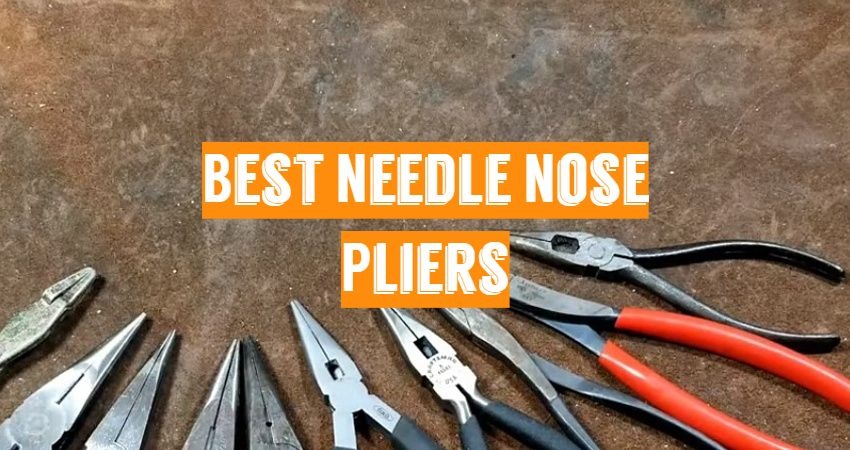
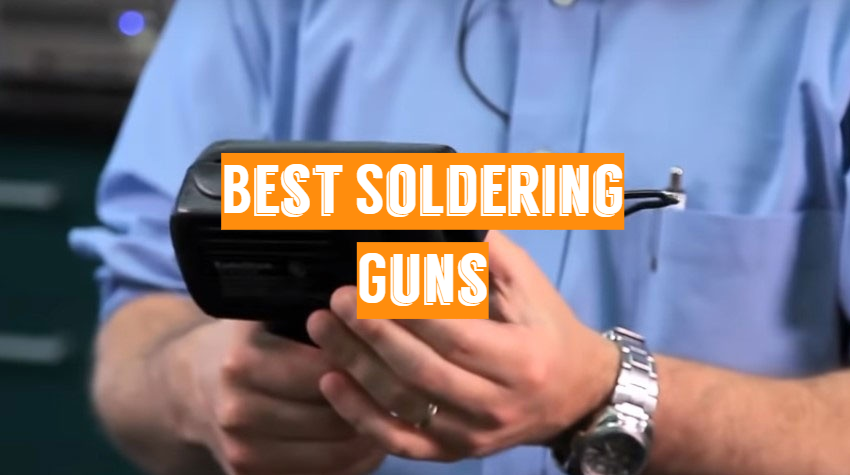
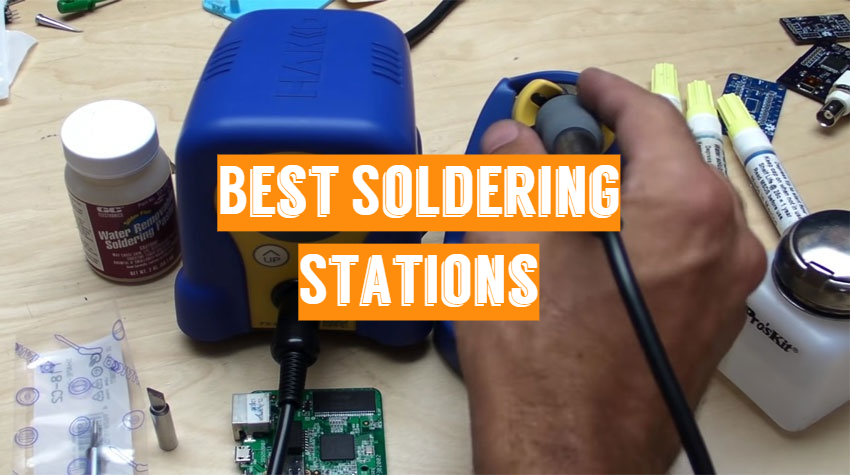
I have so many needle nose pliers around. They come in handy for some many projects around the house. I have a set with a long, tapered nose, elastic precision tips, and other long jaws. You can get a good, solid pair from most hardware stores or even online like Amazon.
If you are working in any type of construction or in a field where you might need to manipulate wires… needle nose pliers are the best solution. They are extremely lightweight and are built to last for a long time. I’ve been using the same one for years.
If you plan to be working with wires often, Needle Nose Pliers will soon become one of your best friends. I use them all the time and they work wonderfully. Never have had any complaints and continue to use them to this day.
Hello, Michael! Thanks for your comment.
Klein Tools make my favorite long nose pliers. I like it because it is useful for grasping tiny objects, reaching difficult locations, holding wires, bending loops, and connecting wires. It’s also great for threading small wires.